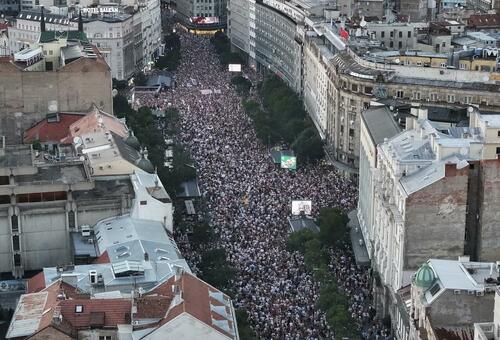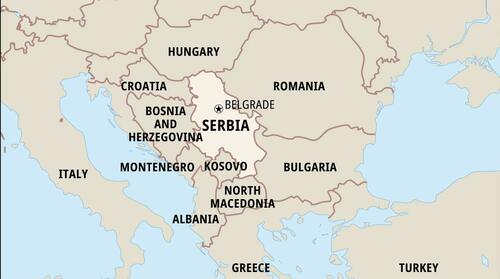
Огромные протесты направлены против литиевого проекта Rio Tinto в Сербии, который станет крупнейшей шахтой в Европе
Массивный проект по добыче лития на ранней стадии в Сербии сталкивается с огромной и оживленной общественной оппозицией.Это ставит под сомнение жизнеспособность ключевого компонента стремления Западной Европы к «зеленому переходу» от ископаемого топлива. Проект Rio Tinto Group работает на гибридном двигателе Экологизм и национализм.
Размер и интенсивность оппозиции были полностью продемонстрированы в начале этого месяца. От 24 000 до 27 000 протестующих наполнили широкие бульвары. В Белграде скандируют «Рио Тинто, убирайся из Сербии» и «Ты не будешь копать» и несут плакаты с надписью «Мы не отдадим Сербию». Другие нарушили движение поездов, заполнив две станции города, а некоторые заблокировали пути.
 Ранее в этом месяце в Белграде тысячи сербов устроили акцию протеста против планируемого литиевого рудника Rio Tinto. (Федя Грулович/Рейтер)
Ранее в этом месяце в Белграде тысячи сербов устроили акцию протеста против планируемого литиевого рудника Rio Tinto. (Федя Грулович/Рейтер)За последние несколько лет проект шахты был делом стоп-энд-гоу. После того, как лицензия Rio Tinto получила зеленый свет в 2019 году, она была отменена в 2022 году на фоне финальной подготовки к всеобщим выборам в Сербии. После нескольких месяцев огромных протестов, подобных тем, что были несколько недель назад. Тогдашний премьер-министр Ана Брнабич сказала, что решение было принято в знак уважения к протестующим, и заявила: Мы положили конец беспорядкам в Сербии. "
Однако в июле этого года, Суд признал отзыв неконституционнымВскоре после этого лицензия была восстановлена. Давление со стороны Европейского союза, вероятно, фигурировало в смене курса — Сербия хочет вступить в ЕС.
Если компания перейдет к добыче, шахта Rio Tinto в долине Джадар в западной части страны будет стоить $2,55 млрд. Крупнейший литиевый рудник в Европе, Это позволит удовлетворить 90% спроса на литий в Европе. Это также обеспечит Rio Tinto место среди мировых лидеров минерала, который является важным ингредиентом литий-ионных батарей.
Фермеры и активисты в Сербии вызвали общенациональные протесты, чтобы остановить строительство первого европейского литиевого рудника Rio Tinto, предупредив, что это загрязнит их землю и поставит под угрозу здоровье населения. pic.twitter.com/6LCy2skmSP
— Reuters Business (@ReutersBiz) 9 августа 2024 г.
В Европе нет зеленого перехода без этого лития. Лучшая собака Rio Tinto в Сербии Чад Блевитт Нью-Йорк Таймс. Его компания уже потратила более полумиллиарда на приобретение земли и разведку, и может пройти еще два года, пока не начнется добыча. Акции Rio Tinto (RIO) закрылись в пятницу на уровне $61,28 и торговались между $59 и $75 за последние 52 недели.
Оппозиционные группы хотят постоянного общенационального запрета на добычу лития и бора. "" Мы не собираемся сдаваться.Шахта не может быть построена на сельскохозяйственных землях.63-летний протестующий Мика Милиованович рассказала Рейтер. Это не имеет ничего общего с политикой. Отдельно 25-летняя Анжела Ройович рассказала о Время«Мне не нужны зеленые автомобили. Мне нужны зеленые яблоки и зеленая трава. "
В рекламном ролике, целью которого является убедить сербов в экономической выгоде рудника и минимальном воздействии на окружающую среду, Рио Тинто говорит, что «критические минералы находятся под поверхностью, отделенной от источников воды». Около 200 километров тоннелей свяжут подземные горные работы. Сельское хозяйство продолжается над шахтой"
Тем не менее, некоторые сербы говорят, что их земля эксплуатируется, а их здоровье подвергается опасности для достижения целей людей за пределами страны. Мы боимся, Сербия будет принесена в жертву, чтобы обеспечить литием электромобили, которые практически никто в Сербии не может себе позволить. Зелено-левое движение со-директор Бильяна Джорджевич рассказала BBC.
Есть и геополитический элемент: Для некоторых шахта является лакмусовой бумажкой, разделяющей тех, кто хочет привести страну в соответствие с США и Западной Европой, и тех, кто хочет поддерживать отношения с Россией.. Когда вспыхнул последний раунд протестов, официальные лица утверждали, что реальной целью было свержение правительства президента Александра Вучича, который сам сказал, что разведка из Российской Федерации указала, что переворот находится в работе.
 С помощью энциклопедии Бриттаника
С помощью энциклопедии БриттаникаПомимо экологов, Члены ультранационалистического, дружественного России Народного Патруля также присоединились к протестам против мин.. Когда Вучич решил поддержать шахту в июле по настоянию ЕС, это было расценено как указание на его намерение уйти из России.
Немецкие чиновники активно продвигают проект, а в прошлом месяце в Белграде побывали канцлер Олаф Шольц и руководители Mercedes Benz. Однако, Немецкая стихия взъерошает перья в Сербии. Драган Карайчич, политик, возглавляющий деревни в окрестностях шахты, сказал: Время Он кипел, когда немцы заверили сербов, что шахта будет в безопасности. Он указал на зверства нацистов, которые имели место в соседнем Драгинаке в 1941 году, когда тысячи гражданских казней последовали за аналогичными гарантиями безопасности местных жителей.
Небойса Петкович, сельский житель, который отправился в Белград, чтобы возглавить протесты 10 августа, сказал: Время, «Пусть немцы спасут планету. Мы должны спасти себя. "
Тайлер Дерден
Туэ, 08/20/2024 - 02:45













